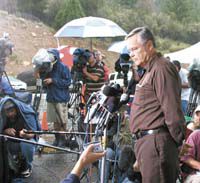| Assistant Secretary of the Mine Safety and Health Administration, Richard Stickler fields questions during one of the press conferences during the Crandall Canyon Mine disaster. |
Hearings have begun on the Crandall Canyon Mine disaster. A United States Senate subcommittee for Labor, Health and Human Services and Education held a hearing on mine safety and preventing future disasters.
Sen. Tom Harkin conducted the meeting. He offered condolences to Richard Stickler, the assistant secretary of labor for the Mine Safety and Health administration on the loss of their employee, Gary Jensen. Harkin quoted a statistic that 104,000 miners have died over the last century.
He wonders why with all technology available, accidents continue to happen. There have been a lot of changes over the years.
Both Senators from Utah, Robert Bennett and Orrin Hatch gave comments and asked questions at the hearings. Sen. Hatch said he is honored to serve the people of Utah. He has the highest regard for the three rescuers that gave their lives. His thoughts and prayers are with the miners and their families. The three rescuers that lost their lives are the best Utah has to offer. They came together as a community and did all they could to save the miners. Sen. Hatch offered congratulations to Richard Stickler from MSHA, Gov. Jon Huntsman Jr. and mayors, Hilary Gordon and Joe Piccolo from Huntington and Price, and Emery County Sheriff LaMar Guymon and his deputies. He said they were all heroes through this disaster.
Sen. Bennett said in the 1920s the death rate of miners was 3.36 miners per 1,000 per year. Now in 2007 it is .2 per 1,000 miners per year. As a nation we have made great progress, but we must continue to make progress and not be lulled into security. Sen. Bennett said it is good that Sec. Elaine Chao is conducting an independent investigation into MSHA’s handling of the mine accident and also Gov. Huntsman is beginning an investigation. “I look forward to the results of these investigations. The state of Utah has unique topography and it may be that solutions that are effective in other parts of the country are not effective in Utah. I hope we can use this tragedy to find out exactly what it is we need to do to make mining as safe as possible, not just for my state but for miners everywhere,” said Sen. Bennett.
Former MSHA director, Davitt McAteer was questioned and he said as mines get deeper the bumps and bounces increase and that is a geological fact. He said seismic detection equipment is in use in South African mines with a depth of two-three miles. This equipment has existed the last 10-15 years. Talk centered around if this equipment should be mandated by MSHA for use in deep mines. Shallow mines without a tendency to bump, would not need the equipment, but McAteer saw it as valuable for use in deep mines such as those in Utah. Sen. Bennett wondered if MSHA has the authority to mandate it now. McAteer said he believes it is something MSHA could take on.
Sen. Bennett said it is his understanding the shallow easy to get to coal is becoming a thing of the past and that mining is going to get more dangerous as we continue to go after the energy our country needs.
Sen. Bennett said Mr. Stickler handled the disaster with as much caring and consideration as he has seen in this situation. Sen. Bennett said he was at the mine site the second day after the first disaster and at that time he understood there would be no recovery effort if the seismic activity continued.
Stickler explained when the disaster occurred the underground miners and mine rescue teams immediately began crawling and probing the areas of entries one-four. This rescue attempt was made in low conditions of approximately 30 inches. Workers blasted a previously sealed area trying to gain access to the trapped miners.
All of that exploration without adequate protection was suspended and the attention turned to the rehabilitation of entry one. Roof bolters were used and crews set the 40 ton water jacks and installed cables and chainlink fencing to secure the ribs. These protections held up from Aug. 7-16. On Aug. 16 another seismic bump occurred which killed three rescuers and injured six others.
Stickler said this underground rescue effort was carried out with the support of MSHA and ground control experts and they were confident it was enough protection. He said he was in the mine several times and felt safe. If they had felt it was unsafe they would have withdrawn.
Sen. Bennett wondered if an incident commander should have been appointed. Stickler replied they operated the rescue efforts with a lot of cooperation with the mining company, MSHA and other experts. They cooperatively worked to come up with the best ideas. He said every disaster situation is different and he has found working together cooperatively works best. If MSHA totally takes control then what responsibility does the mining company have. “It would be a monumental task to replace the mine operator. I lean toward a cooperative effort.”
This is the first in a several part series concerning the hearings into the Crandall Canyon Mine disaster. Read the continuing portion of the series in the Sept. 25 edition of the Emery County Progress.

